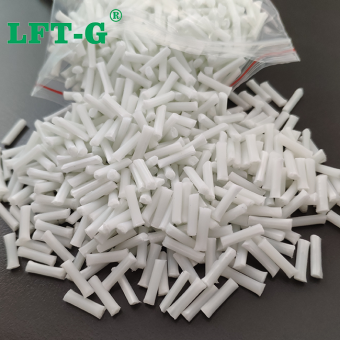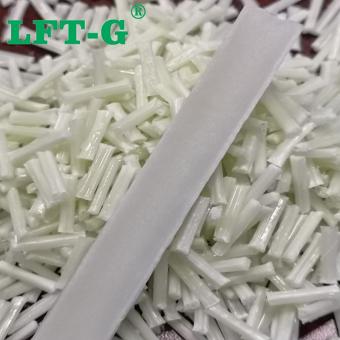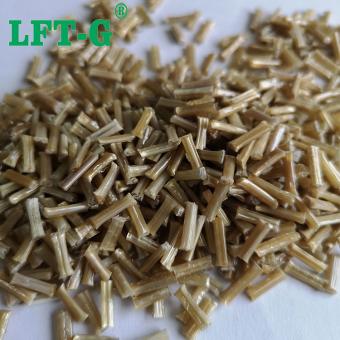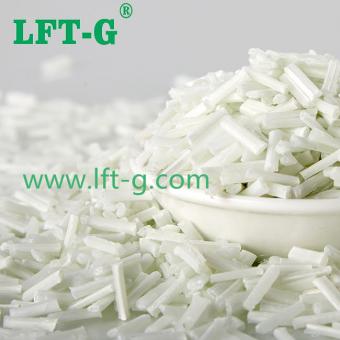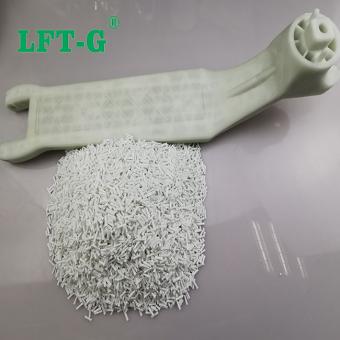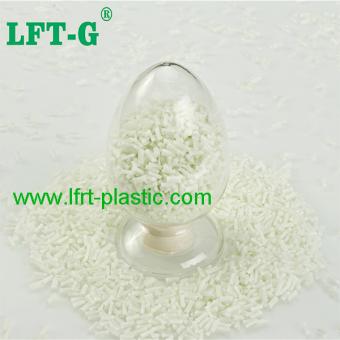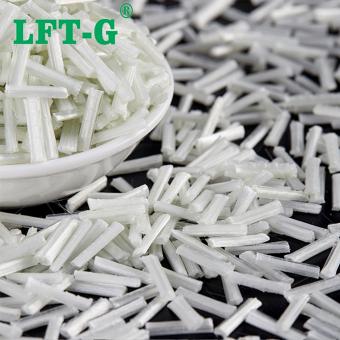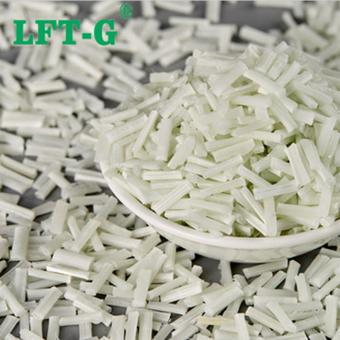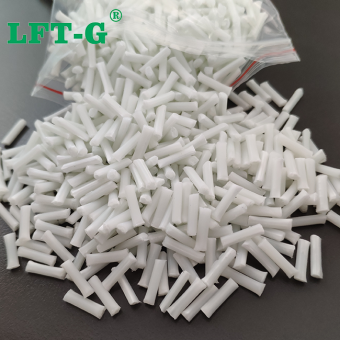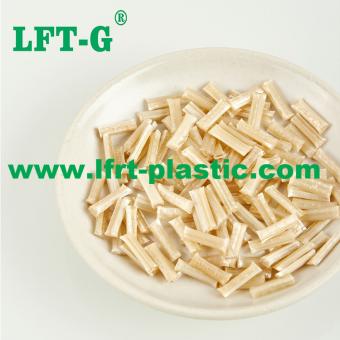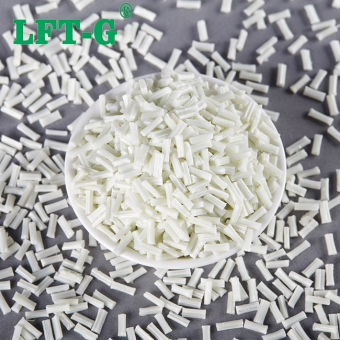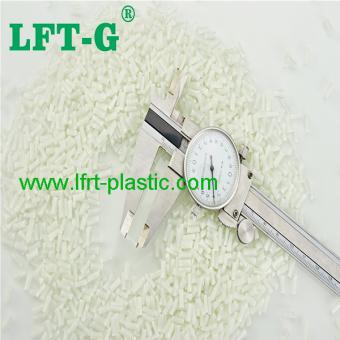-
PEEK poly-ether-ether-ketone composite long glass fiber filing resin for automotivePEEK can also be called polyether ether ketone, as a kind of high-performance semi-crystalline plastic, this kind of plastic has excellent chemical resistance, large mechanical strength, good dimensional stability and a series of excellent properties, according to the performance of the PEEK material is divided into a variety of series of materials, the most common classification of PEEK material is peek original material, glass fiber or carbon fiber modification.view more
-
2023 New MXD6 meta-xylylene adipamide nylon Long glass fiber filling 30% high barrier propertiesWhat is MXD6? Conventional aliphatic nylon is easy to process but has strong water absorption and low glass conversion temperature. Although all-aromatic nylon has solved the shortcomings of aliphatic products to a large extent, the processing difficulty has increased exponentially. After 1972, Toyo Textile and Mitsubishi Gas Chemical synthesized a new kind of semi-aromatic nylon MXD6, which not only overcame the disadvantages of aliphatic and all-aromatic resins to a large extent, but also had some advantages of all-aromatic resins. It is widely used in packaging materials with high gas barrier and engineering structural materials. In summary, MXD6 has the following advantages: High strength and elastic modulus; The high glass transition temperature is 237℃ for Tm and 85℃ for Tg. Low water absorption and moisture permeability; Fast crystallization speed, easy to form and manufacture; Excellent gas barrier performance. Why add Long Glass Fiber? Long glass fiber reinforced composite can solve your problems when other methods of reinforced plastics do not provide the performance you need or if you want to replace matal with plastic. Long Glass Fiber reinforced composites can cost-effectively reduce the cost of goods and effectively improve the mechanial properties of engineering internal skeleton network. Performance is preserved in a wide range of environments. MXD6 performance and application Compared with other materials, MXD6 has the advantages of high strength and elastic modulus, high glass transition temperature, low water absorption and moisture permeability, fast crystallization speed, convenient molding and manufacturing, excellent gas barrier properties, and can also be a good barrier to carbon dioxide and oxygen even under high humidity. In the end market, MXD6 is rarely used alone and is generally added to other polymers as a modified component. Materials containing MXD6 are mainly used in automotive and packaging fields. As an engineering plastic, MXD6 can replace the use of metal materials in the automotive industry, such as power tools, magnetic materials, automotive shell, chassis, girders, engine accessories, etc. We will offer you: 1) LFT & LFRT material technical parameters and leading edge design; 2) Mold front design and recommendations; 3)Provide technical support such as injection molding and extrusion molding. System Certification Quality Management System ISO9001/1949 Certification National Laboratory Accreditation Certificate Modified Plastics Innovation Enterprise Honorary Certificate Heavy metal REACH & ROHS testing
- New material
- Polycondensation product
- Crystalline polymer
- Special nylon
- Polyamide fibre
- Long glass fiber composite
Tags :
-
LFT-G PPS Polyphenylene sulfide composite long glass fiber thermoplastic resin original colorPPS information The resin matrix of thermoplastic composites involves general and special engineering plastics, and PPS is a typical representative of special engineering plastics, commonly known as "plastic gold". Performance advantages include the following aspects: excellent heat resistance, good mechanical properties, corrosion resistance, self-flame retardant up to UL94 V-0 level. Because PPS has the advantages of the above properties, and compared with other high performance thermoplastic engineering plastics and has the characteristics of easy processing, low cost, so it becomes an excellent resin matrix for manufacturing composite materials. PPS composite material PPS filling short glass fiber (SGF) composite material has the advantages of high strength, high heat resistance, flame retardant, easy processing, low cost, and has been applied in automotive, electronics, electrical, machinery, instruments, aviation, aerospace, military and other fields. PPS filling long glass fiber (LGF) composite material has the advantages of high toughness, low warpage, fatigue resistance, good product appearance and so on. It can be used in water heater impeller, pump shell, joint, valve, chemical pump impeller and shell, cooling water impeller and shell, household appliance parts and so on. What are the specific differences between short glass fiber (SGF) and long glass fiber (LGF) reinforced PPS composites? 1. Mechanical property analysis The reinforcement fiber added in the resin matrix can form a supporting skeleton, and the reinforcement fiber can effectively bear the external load when the composite is subjected to external force. At the same time, energy can be absorbed by fracture, deformation and other ways to improve the mechanical properties of resin. The tensile strength and bending strength of the composites are gradually increased by increasing the amount of glass fiber. The main reason is that when the glass fiber content increases, more glass fiber in the composite material can withstand the action of external force. Meanwhile, due to the increase in the number of glass fibers, the resin matrix between the glass fibers becomes thinner, which is more conducive to the construction of glass fiber reinforced frame. Therefore, with the increase of glass fiber content, more stress is transferred from resin to glass fiber under external load, which effectively improves the tensile and bending properties of composite materials. The tensile and bending properties of PPS/LGF composites are higher than those of PPS/SGF composites. When the glass fiber mass fraction is 30%, the tensile strength of PPS/SGF and PPS/LGF composites is 110MPa and 122MPa, respectively. The bending strength was 175MPa and 208MPa, respectively. The flexural elastic modulus were 8GPa and 9GPa, respectively. The tensile strength, bending strength and bending elastic modulus of PPS/LGF composites are increased by 11.0%, 18.9% and 11.3% compared with PPS/SGF composites, respectively. PPS/LGF composites have higher length retention rate of glass fiber. Under the condition of the same glass fiber content, the composites have stronger load resistance and better mechanical properties. When the glass fiber content is low, the impact strength of the composite decreases. The main reason is that the lower glass fiber content cannot form a good stress transfer network in the composite material, so that the glass fiber exists in the form of defects under the impact load of the composite material, resulting in the overall impact strength of the composite material is reduced. With the increase of the glass fiber content, the glass fiber in the composite can form an effective spatial network, and the reinforcement effect is greater than that of the glass fiber tip. Under the action of external load, the external load can be transferred to the reinforced fiber better, thus improving the overall performance of the composite. In the PPS/LGF system, the length of the glass fiber is longer and the spatial network is more dense. The reinforced glass fiber has greater bearing capacity and better impact strength. When the mass fraction of glass fiber is 30%, the impact strength of PPS/LGF is increased by 19.4% from 31kJ/m2 to 37kJ/m2, and the notch impact strength is increased by 54.5%(from 7.7kJ/m2 to 11.9kJ/m2). 2. Thermal properties analysis of PPS/SGF and PPS/LGF composites When the mass fraction of glass fiber is 30%, the thermal deformation temperature of PPS/SGF composite and PPS/LGF composite reaches 250℃ and 275℃, respectively. The thermal deformation temperature of PPS/LGF composite is 10% higher than that of PPS/SGF composite. The main reason is that the introduction of glass fiber makes the network skeleton of reinforced fiber formed inside the composite material, which greatly improves the heat resistance of the composite material. The size of glass fiber in PPS/LGF is longer, and the heat resistance improvement advantage is more obvious....
- New high performance thermoplastic resin
- A crystalline polymer
- Long glass fiber filling plastic
- Customized material
- Industrial raw material
- High impact resistance
Tags :
-
Transparent and light PP Long Glass Fiber composite material thermoplastic resin sample freePolypropylene (PP), as one of the five general plastics, is widely used in all walks of life
- white plastic material
- long glass fiber
- PP composite
- plastic grains
- Polypropylene fibre
- glass fiber filling plastic
Tags :
-
LFT-G brand PA6 Polyamide6 nylon6 filling long glass fiber40 orginal color for automotive partsWhat is PA6 plastic? polyamide (PA), usually called Nylon, is a hetero-chain polymer containing amide group (-NHCo -) in the main chain. It can be divided into aliphatic group and aromatic group. It is the earliest developed and the most used thermoplastic engineering material. Polyamide main chain contains many repeated amide group, used as a plastic called nylon, used as a synthetic fiber called nylon. A variety of different polyamides can be prepared according to the number of carbon atoms contained in binary amines and dibasic acids or amino acids. At present, there are dozens of polyamides, among which polyamide-6, polyamide-66 and polyamide-610 are the most widely used. Polyamide-6 is an aliphatic polyamide, with light weight, strong strength, wear resistance, weak acid and alkali resistance and some organic solvents, easy molding and processing and other excellent properties, widely used in fiber, engineering plastics and thin films and other fields, but PA6 molecular chain segment contains strong polarity amide groups, easy to form hydrogen bonds with water molecules, The product has the disadvantages of large water absorption, poor dimensional stability, low impact strength in dry state and low temperature, strong acid and alkali resistance. Advantages of nylon 6: High mechanical strength, good toughness, high tensile and compressive strength. Outstanding fatigue resistance, the parts after repeated bending can still maintain the original mechanical strength. High softening point, heat resistant. Smooth surface, small friction coefficient, wear-resistant. Corrosion resistance, very resistant to alkali and most salts, also resistant to weak acids, oil, gasoline, aromatic compounds and general solvents, aromatic compounds are inert, but not resistant to strong acids and oxidants. It can resist the corrosion of gasoline, oil, fat, alcohol, alkaline and so on, and has good anti-aging ability. It is self-extinguishing, non-toxic, odorless, good weather resistance, inert to biological erosion, and has good antibacterial and mildew resistance. Has excellent electrical performance, good electrical insulation, nylon volume resistance is high, high breakdown voltage resistance, in dry environment, can work frequency insulation material, even in high humidity environment still has good electrical insulation. Light weight, easy dyeing, easy forming, because of low melting viscosity, can flow quickly. Disadvantages of Nylon 6: Easy to absorb water, water absorption, saturated water can reach more than 3%. Poor light resistance, in the long-term high temperature environment will oxidize with oxygen in the air, the color turns brown at the beginning, and the subsequent surface is broken and cracked. Injection molding technology requirements more strict, the existence of trace moisture will cause great damage to the quality of molding; The dimensional stability of the product is difficult to control because of thermal expansion. The existence of sharp Angle in the product will lead to stress concentration and reduce the mechanical strength; If the wall thickness is not uniform, it will lead to the distortion and deformation of the parts. High precision of equipment is required in post-processing. Will absorb water, alcohol and swelling, not resistant to strong acid and oxidant, can not be used as acid-resistant materials. Why filling Long Glass Fiber? PA6 has excellent properties such as light weight, strong strength, abrasion resistance, weak acid and alkali resistance and some organic solvents, and easy molding and processing. It is widely used in the fields of fibers, engineering plastics and films. However, the molecular chain segment of PA6 contains highly polar amide groups, which are easy to form hydrogen bonds with water molecules. The product has the disadvantages of large water absorption, poor dimensional stability, low impact strength in dry state and low temperature, strong acid and alkali resistance. With the development of science and technology and the improvement of life quality, the defects in some properties of traditional PA6 materials have limited its development in some fields. In order to improve the performance of PA6 and expand its application field, PA6 should be modified. Filling enhancement modification is a common method for physical modification of PA6. It refers to the modification of PA6 by adding fillers such as glass fiber and carbon fiber into the matrix to significantly improve the mechanical properties, flame retardant properties, thermal conductivity and dimensional stability of the material. What is application of PA6-LGF? Modified section of 30% long glass fiber reinforced PA6 is the ideal material for processing power tool shell, power tool parts, engineering machinery parts and automobile parts. Its mechanical properties, dimensional stability, heat resistance and aging resistance have been significantly improved. The fatigue resistance strength is 2.5 times that of unenha...
- Polyamide 6 composite
- lgf thermoplastic resin
- High impact PA6
- injection molding plastic
- pa6 filling long glass fiber
- Reinforced plastic
Tags :
-
Xiamen lft Polyamide6 long glass fiber reinforced plastic high toughness lightweight 12mmPA66 filling LGF Nylon (PA) has a series of excellent properties, such as high mechanical strength, chemical resistance, oil resistance, wear resistance, self-lubrication, easy processing and forming, and has become one of the thermoplastic engineering plastics widely used at home and abroad. But in the practical application, the performance requirements of nylon are different under different conditions or environment. For example, electric drill and motor shell, pump impeller, bearing, diesel engine and air conditioning fan and other parts require nylon material to have high strength, high rigidity and high dimensional stability; Because of the poor toughness of nylon at low temperature, it is necessary to toughen it. In some outdoor applications, nylon materials must be weather-resistant modification in long-term outdoor environment. The reinforced materials used for nylon are mainly glass fiber, carbon fiber, whiskers and other fibrous materials, and the glass fiber reinforced is the most widely used. The glass fiber reinforcement can obviously improve the rigidity strength and hardness of the material, and the dimensional stability and heat resistance of the material are obviously improved. Because nylon itself is not strong enough, by adding 10 to 30 percent of the fiber, to increase its strength. In particular, 30% strength is considered the most appropriate ratio. Also added to 40-50%, according to the specific requirements of different products, coupled with the appropriate formula, can be successful. Production technology of glass fiber reinforced nylon Long fiber method, that is, nylon and other components are premixed and added to the hopper, and the glass fiber from the glass fiber entrance through the screw rotation into the screw, and then mixed with nylon resin. Factors affecting the properties of glass fiber reinforced nylon Firstly, the interface bond between glass fiber and nylon resin has the most important effect on glass fiber reinforced nylon. If the combination between the two is not good, the reinforcement effect will be greatly reduced. At this time, the surface treatment of glass fiber is particularly important. Today, fiberglass manufacturers have been able to produce fiberglass models for different materials with different surface treatments for use by modified plastics manufacturers, as long as the right choice. Second, the length of glass fiber in nylon material is another major factor affecting its properties. In general, long glass fibers are superior to short glass fibers in terms of tensile strength, bending strength and modulus, and notched impact strength. At the same time, the dispersion of glass fiber in the material can not be ignored. The dispersion of glass fiber mainly depends on the appropriate shearing action of twin-screw and the kneading action of material, which involves the combination and speed of screw. The selection of screw speed is related to the content of additives such as glass fiber in the formula. For flame-retardant reinforced nylon, low speed is appropriate because the flame retardant has been decomposed by heat. In addition, processing temperature, glass fiber diameter, glass fiber type will also affect the final performance of the material, so it will not be repeated here. Glass fiber enhances the fluidity of nylon The fluidity of glass fiber reinforced nylon is poor, and problems such as high injection pressure, high injection temperature, dissatisfaction with injection molding and poor surface quality are easy to occur in the process of injection molding, which seriously affect the appearance of products and lead to a high defect rate of products. Especially in the production process of injection molding products, and can not directly add lubricant to solve the problem, can only be improved on the raw material, generally speaking, this needs to be added in the modified formula lubrication componentS. Resistance of glass fiber reinforced nylon to high temperature heat and oxygen aging In some applications such as bearings and diesel fans, glass fiber reinforced nylon often faces the problem of long time high temperature thermal and oxygen aging. Although the reinforced modification of nylon with glass fiber can moderately improve the heat resistance of nylon, it can not solve the problem well. Better results can be achieved by adding appropriate anti-thermal oxygen aging additives to the glass fiber reinforced nylon composite material, as shown in the figure above. Glass fiber enhances the weather resistance of nylon Nylon under the influence of sunlight, temperature change, wind and rain and other external conditions, there will be a series of aging phenomena such as fading, discoloration, cracking, powder and strength reduction, among which UV is the key factor to promote aging. Weather resistant nylon is currently mainly black products, that is, by adding carbon black and other ultraviolet absorption additives in nylon to solve its weather re...
- pa66 nylon plastic
- Polyamide66 long glass fiber
- pa66 fill gf
- raw material plastic pa66
- composite materials pa66
- thermoplastic resin
Tags :
-
LFT TPU fill long glass fiber reinforced material plastic grains original color 12mmWhat is the TPU plastic? Thermoplastic polyurethane (TPU) elastomer is a linear polymer formed by the interaction of hard chain segment and soft chain segment. Tpus have physical properties such as tensile, wear and heat resistance, elasticity similar to rubber, and Tpus can be processed in the processing of thermoplastic materials, such as injection molding, extrusion, blow molding, calendering and honing. What is Long Glass Fiber(LGF)? Long glass fiber reinforced composites can solve your problems when other methods of reinforced plastics do not provide the performance you need or if you want to replace metal with plastic. Long glass fiber reinforced composites can cost-effactively reduce the cost of goods and effectively improve the mechanical properties of engineering polymers, and increase the durability by forming long fibers to form a long-fiber-reinforced internal skeleton network. Performance is preserved in a wide range of environments. Tpus have good impact resistance, but in some applications, high elastic modulus and very hard materials are required. Glass fiber reinforced modification is a common technical means to improve the elastic modulus of materials. Through modification, thermoplastic composites with high elastic modulus, good insulation, strong heat resistance, good elastic recovery performance, good corrosion resistance, impact resistance, low expansion coefficient and dimensional stability can be obtained. What is the performance of TPU-LGF50? The datasheet is tested by our own lab, for your reference only. Application of TPU-LGF20 Please feel free to contact us if you are unsure whether the material is suitable to use. Detailed information Product name Color Advantage After sales service Shipment Port MOQ Delivery time Packing details 20% Long Glass Fiber reinforced TPU Original color(can be customized) High toughness, high rigidity, low warpage, low water absorption, high dimensional stability, chemical resistance, good appearance 24h online Xiamen Port 25KG 7-15 days after payment 25kg/bag Other products are hot selling too PA6-LGF PA12-LGF
- Composite plastic
- raw material TPU reinforced
- LGF TPU
- TPU thermoplastic resin
- TPU filling long glass fiber
Tags :
-
HDPE LFT-G filling Long Glass Fiber 20%-60% natural grade high performance sample availableHDPE introduce High density polyethylene (HDPE) is a white powder or granular product. Non-toxic, tasteless, crystallinity is 80% ~ 90%, softening point is 125 ~ 135℃, the use of temperature can reach 100℃; The hardness, tensile strength and creep property are better than low density polyethylene. Good wear resistance, electrical insulation, toughness and cold resistance; Good chemical stability, at room temperature, insoluble in any organic solvent, acid, alkali and all kinds of salt corrosion resistance; Thin film to water vapor and air permeability is small, low water absorption; Poor aging resistance, environmental stress cracking resistance is not as good as low density polyethylene, especially thermal oxidation will reduce its performance, so the resin must be added in antioxidants and ultraviolet absorbent to improve this deficiency. High density polyethylene film under the condition of stress thermal deformation temperature is low, should pay attention to the application. Long Glass Fiber filling High density polyethylene (HDPE)/ glass fiber (LGF) composites were prepared by twin-screw extrusion mechanism, and the mechanical properties and non-isothermal crystallization behavior of HDPE/LGF composites were studied. The results show that the impact strength of the composite can be improved by MAH-g-POE, and the interface bond between the glass fiber and HDPE is good. The Avrami index (n) of the composite does not change with the cooling rate. The effects of HDPE on the flow properties of PP and its mechanical properties, and the effects of the flow properties of PP/HDPE blends on the mechanical properties of LGF/PP/HDPE composites were studied. The results show that HDPE can not only improve the impact performance of PP, but also improve the liquidity of PP. The mechanical properties of LGF/PP/HDPE composites, such as tensile strength and bending strength, are mainly affected by the flow properties of the matrix, but have little effect on the mechanical properties of the matrix itself. Datasheet Tested by own lab, for your reference only. Application cases Package and Warehouse Self-owned factory Exhibitions and customers Frequently asked questions 1. Under what circumstances can long fiber replace short fiber? What are the common alternative materials? A: Traditional staple fiber materials can be replaced with long glass fiber and long carbon fiber LFT materials in the case of customers whose mechanical properties cannot be met or where higher metal substitutes are desired. For example, PP long glass fiber is often replacing nylon reinforced glass fiber, and nylon long glass fiber is replacing PPS series. 2. How to choose the fiber content of the product? Is the larger product suitable for higher content material? A: This is not absolute. The content of glass fiber is not more is better. The suitable content is just to meet the requirements of each products. 3. If want to increase the anti-aging properties of the product, is it possible to add anti-UV agent to the material? A: You can choose some materials which are better resistant to aging, and then add some antioxidants and UV absorbers to the materials, to improve the aging resistance of the products.
- HDPE filling lgf
- High Density Polyethylene raw material
- Granular plastic HDPE
- Reinforced materials HDPE
- long fiber material
Tags :
-
lft-g brand ABS raw material fill long glass fiber high quality own-factory made original gradeABS-LGF Long glass fiber reinforced ABS can improve the thermal deformation temperature and mechanical properties of ABS, and reduce the shrinkage rate and linear expansion coefficient of ABS. It is used to manufacture products with high dimensional precision. Fiber reinforced ABS general glass fiber content is 20% to 60%. The addition of 20% to 30% glass fiber is the most common. Generally speaking, the higher the long glass fiber content, the better the tensile strength, bending strength, elastic modulus and rigidity of the material, and the thermal deformation temperature also has a significant increase. However, if the long glass fiber is added too much, it will make the tensile strength, bending strength, elastic modulus, rigidity and other properties of the material decline. Datasheet of ABS-LGF30 Tested by our own lab, for your reference only. Appearance From the appearance of ABS plastic raw materials, it is mainly a kind of opaque ivory grain, non-toxic, tasteless, low water absorption characteristics can make its products into a variety of colors, and has more than 90% high gloss. ABS combines well with other materials and is easy for surface printing, coating and plating treatment. Application Xiamen LFT composite plastic Co.,ltd Our company is a brand-name company that focuses on LFT&LFRT. Long Glass Fiber Series (LGF) & Long Carbon Fiber Series (LCF). The company's thermoplastic LFT can be used for LFT-G injection molding and extrusion, and can also be used for LFT-D molding. It can be produced according to customer requirements: 5~25mm in length. The company's long-fiber continuous infiltration reinforced thermoplastics have passed ISO9001&16949 system certification, and the products have obtained lots of national trademarks and patents.
- Acrylonitrile Butadiene Styrene
- lgf composite abs
- industrial use abs fiber
- ABS filling lgf
- abs compound long glass fiber
- fiberglass ABS
Tags :
-
PPS raw material filled long glass fiber lgf 40% high toughness car parts and other filedWhat is PPS? PPS has a symmetrical rigid backbone and is part of a crystalline polymer consisting of repeated parapplacement of benzene rings and sulfur atoms. PPS are special engineering plastics with high performance, high melting point up to 280℃, which can replace metal. They are located at the top of the polymer property pyramid, as shown in Figure 1. Therefore, based on the excellent performance of PPS resin, make it meet the requirements of harsh engineering plastic projects for materials. Why filling long glass fiber? Long glass fiber reinforced plastic is on the basis of the original pure plastic, adding glass fiber and other additives, so as to improve the scope of use of materials. Advantages: 1. After glass fiber reinforcement, glass fiber is a high temperature resistant material, therefore, the heat resistance temperature of reinforced plastics is much higher than before without glass fiber, especially nylon plastics; 2. After glass fiber reinforcement, due to the addition of glass fiber, limited the mutual movement between polymer chains of plastics, therefore, the shrinkage rate of reinforced plastics decreases a lot, rigidity is greatly improved; 3. After glass fiber reinforcement, the reinforced plastic will not stress crack, at the same time, the anti-impact performance of plastic is improved a lot; 4. After glass fiber reinforcement, glass fiber is a high strength material, which also greatly improves the strength of plastic, such as: tensile strength, compression strength, bending strength, improve a lot; 5. glass fiber reinforced after, due to the addition of glass fiber and other additives, the combustion performance of reinforced plastics decreased a lot, most of the material can not ignite, is a kind of flame retardant material. Datasheets for your reference Performance advantages include the following aspects: excellent heat resistance, good mechanical properties, corrosion resistance, self-flame retardant up to UL94 V-0 level. Because PPS has the advantages of the above properties, and compared with other high performance thermoplastic engineering plastics and has the characteristics of easy processing, low cost, so it becomes an excellent resin matrix for manufacturing composite materials. Details Color Original or as required Length Above 5~24mm MOQ 25kg Package 25kg a bag Port of Loading Xiamen Port Delivery time 7~15 days after shipment
- Polyphenylene sulfide composite
- long glass fiber compound pps
- LFT-G brand plastic
- LGF PPS reinforced material
- Injection grade PPS
- pellets of plastic pps
Tags :
-
PA6 Nylon6 Polyamide6 composite Long Glass Fiber modified plastic 12mm in length original colorPA6 material PA6 is one of the most widely used materials in the current field, and PA6 is a very good engineering plastic with balanced and good performance. The raw materials for the manufacture of nylon 6 engineering plastic are extensive and inexpensive, and it is not restricted by the technological monopoly of foreign companies. However, in order to make good use of this inexpensive and excellent material, we must first understand it. Today, we will start with glass fiber reinforced PA6 engineering plastics, because it is the most important category of PA6 engineering plastics. Just like any other engineering plastics, PA6 has advantages and disadvantages, such as high water absorption, low temperature impact toughness and dimensional stability is relatively poor. So engineers will use different methods to make PA6 better, which we call modification. At present, the most common method is to blend and modify PA6 with glass fiber (GF). Today, we will take a look at the mechanical properties of PA6 engineering plastics under the glass fiber GF system for reference and help us select materials. PA6-LGF 1. Influence of glass fiber content on PA6 engineering plastics We can find from the application and experiment that the content index is often one of the biggest influencing factors in fiber reinforced composites. As the glass fiber content increases, the number of glass fibers per unit area of the material will increase, which means that the PA6 matrix between the glass fibers will become thinner. This change determines the impact toughness, tensile strength, bending strength and other mechanical properties of glass fiber reinforced PA6 composites. In terms of impact performance, the increase of glass fiber content will greatly increase the notch impact strength of PA6. Taking long glass fiber (LGF) filling PA6 as an example, when the filling volume increases to 35%, the notch impact strength will increase from 24.8J/m to 128.5J/m. But the glass fiber content is not more is better, short glass fiber (SGF) filling volume reached 42%, the impact strength of the material reached the highest 17.4kJ/㎡, but continue to add will let the gap impact strength showed a downward trend. In terms of bending strength, the increase of the amount of glass fiber will make the bending stress can be transferred between the glass fiber through the resin layer; At the same time, when the glass fiber is extracted from the resin or broken, it will absorb a lot of energy, thus improving the bending strength of the material. The above theory is verified by experiments. The data show that the bending elastic modulus increases to 4.99GPa when the LGF (long glass fiber) is filled to 35%. When the content of SGF (short glass fiber) is 42%, the bending elastic modulus reaches 10410MPa, which is about 5 times that of pure PA6. 2. Influence of glass fiber retention length on PA6 composites The fiber length of the glass fiber also has an obvious effect on the mechanical properties of the material. When the length of the glass fiber is less than the critical length (the length of the fiber when the material has the tensile strength of the fiber), the interface binding area of the glass fiber and the resin increases with the increase of the length of the glass fiber. When the composite material is broken, the resistance of the glass fiber from the resin is also greater, so as to improve the ability to withstand the tensile load. When the length of glass fiber exceeds the critical, the longer glass fiber can absorb more impact energy under impact load. In addition, the end of the glass fiber is the initiation point of crack growth, and the number of long glass fiber ends is relatively less, and the impact strength can be significantly improved. The experimental results show that the tensile strength of the material increases from 154.8MPa to 164.4MPa when the glass fiber content is kept at 40% and the length of the glass fiber increases from 4mm to 13mm. The bending strength and notched impact strength increased by 24% and 28%, respectively. Moreover, the research shows that when the original length of the glass fiber is less than 7mm, the material performance increases more obviously. Compared with short glass fiber, long glass fiber reinforced PA6 material has better appearance warping resistance, and can better maintain mechanical properties under high temperature and humidity conditions. TDS for your reference PA6 can be made into long glass fiber reinforced material by adding 20%-60% long glass fiber according to the characteristics of the product. PA6 with long glass fiber added has better strength, heat resistance, impact resistance, dimensional stability and warping resistance than without glass fiber added. Following TDS show the data of PA6-LGF30. Application PA6-LGF has the largest proportion of applications in the automotive industry, by electronic and electrical applications, and also involving machinery and engineering ...
- PA6 thermoplastic resin materials
- nylon 6 granules
- glass fiber reinforced plastics granules
- long fiber compounds pa6
- Injection molding plastic
- LFT-G reinforced material
Tags :
-
LFT reinforced plastic PA12 filling Long Glass Fiber original white color for sports parts and solar energyPA12 Nylon 12 is the least dense of the nylon series at 1.02. Its characteristics include low water absorption, good dimensional stability, good low temperature resistance, up to -70℃; Low melting point, easy forming processing, forming temperature range is wide; Soft, chemical stability, oil resistance, wear resistance are good, and is a self-extinguishing material. The long-term use temperature is 80℃ (up to 90℃ after heat treatment), can work at 100℃ for a long time in oil, inert gas can work at 110℃ for a long time. Long Glass Fiber Long fiber reinforced thermoplastics (fibrereinforced thermoplastics), referred to as LFT, refers to glass fiber reinforced composite materials (LFT) with a length of more than 5mm, has good molding processing properties, can be molded by injection, molding, extrusion and other processes, When forming, the plastic has good molding fluidity, and can be formed under low pressure. It can be formed into products with complex shapes, and the apparent mass of products is better than GMT. TDS for reference only Application Packing Industry introduction LFT & LFRT, long fiber reinforced thermoplastic engineering plastics, compared to conventional short fiber reinforced thermoplastics, typically have a fiber length of less than 1 to 2 mm in conventional short fiber reinforced thermoplastics, while the LFT process the thermoplastic engineering plastics produced have been able to maintain fiber lengths above 5 to 25 mm. The long fiber is impregnated with a special resin system to obtain a long strip which is sufficiently wetted by the resin, and then cut into a desired length as required. The most used matrix resin is PP, by PA6, PA66, PPA, PA12, MXD6, PBT, PET, TPU, PPS, LCP, PEEK and the like. Conventional fibers include glass fiber and carbon fiber. Special fibers include basalt fiber and quartz fiber. The LFT of the long fiber material can achieve better mechanical properties. According to the final different applications, the finished product can be used for injection molding, extrusion and molding, Etc., directly used to replace steel and thermoset products.
- long glass fiber polyamide12
- long fibre reinforced thermoplastics
- pa12 lgf30
- polyamide 12 lgf30
- lft pa6 modified
Tags :

 e-mail
e-mail English
English français
français Deutsch
Deutsch русский
русский italiano
italiano español
español português
português العربية
العربية 日本語
日本語 한국의
한국의 中文
中文












